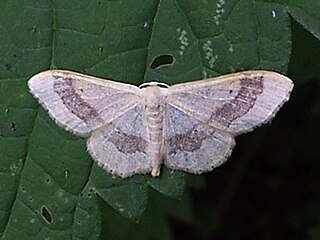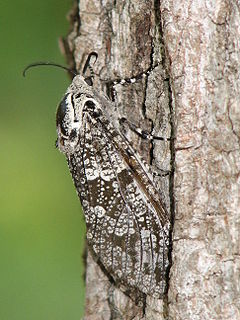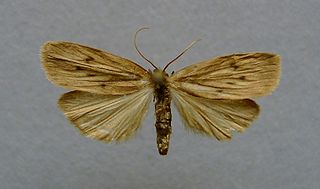
Otto Staudinger was a German entomologist and a natural history dealer considered one of the largest in the world specialising in the collection and sale of insects to museums, scientific institutions, and individuals.

Idaea, sometimes called Hyriogona, is a large genus of geometer moths. It was erected by Georg Friedrich Treitschke in 1825. They are found nearly worldwide, with many native to the Mediterranean, the African savannas, and the deserts of western Asia.

The Cossinae are the nominate subfamily of the Cossidae. The caterpillars of several Cossinae species, such as the carpenterworm and the goat moth, are significant pests. On the other hand, in Chile the caterpillars of the Chilean moth are collected on a commercial scale for sale as fishing bait and terrarium pet food; they are usually called "butterworms" in international trade.

Pelosia is a genus of moths in the family Erebidae. The genus was erected by Jacob Hübner in 1819.

Pelosia muscerda, the dotted footman, is a moth of the family Erebidae. The species was first described by Johann Siegfried Hufnagel in 1766. It is found in the Palearctic realm.

Charissa is a genus of moths in the family Geometridae.

Sphingulini is a tribe of moths of the family Sphingidae. The tribe was described by Walter Rothschild and Karl Jordan in 1903.

Ancylosis is a genus of snout moth. It was described by Philipp Christoph Zeller in 1839, and is known from South Africa, Uzbekistan, Spain, Turkmenistan, Lebanon, Algeria, Tunisia, Russia, Israel, Palestine, Tinos, Australia, Seychelles, Afghanistan, the United States, Iraq, Namibia, Kazakhstan, Iran, Mauritius, Mozambique, Sarepta, Argentina, Sri Lanka, and Aden.

Dyspessa is a genus of moths belonging to the family Cossidae. It was described by Jacob Hübner in 1820.

Taenaris is a genus of butterflies in the family Nymphalidae that live in Australasia. All species have highly developed eyespots that are either blue or yellow.

Pelosia obtusa, the small dotted footman, is a moth of the family Erebidae. The species was first described by Gottlieb August Wilhelm Herrich-Schäffer in 1847. It is found from central Europe through Asia to the Pacific Ocean.
Pelosia angusta is a moth of the family Erebidae. It was described by Otto Staudinger in 1887. It is found in the Russian Far East and Japan.
Cossulus is a genus of moths in the family Cossidae.

Hyponephele is a genus of butterflies of the subfamily Satyrinae in the family Nymphalidae. Most range from Europe into central Asia with a few in northern Africa. They are commonly called meadowbrowns.










